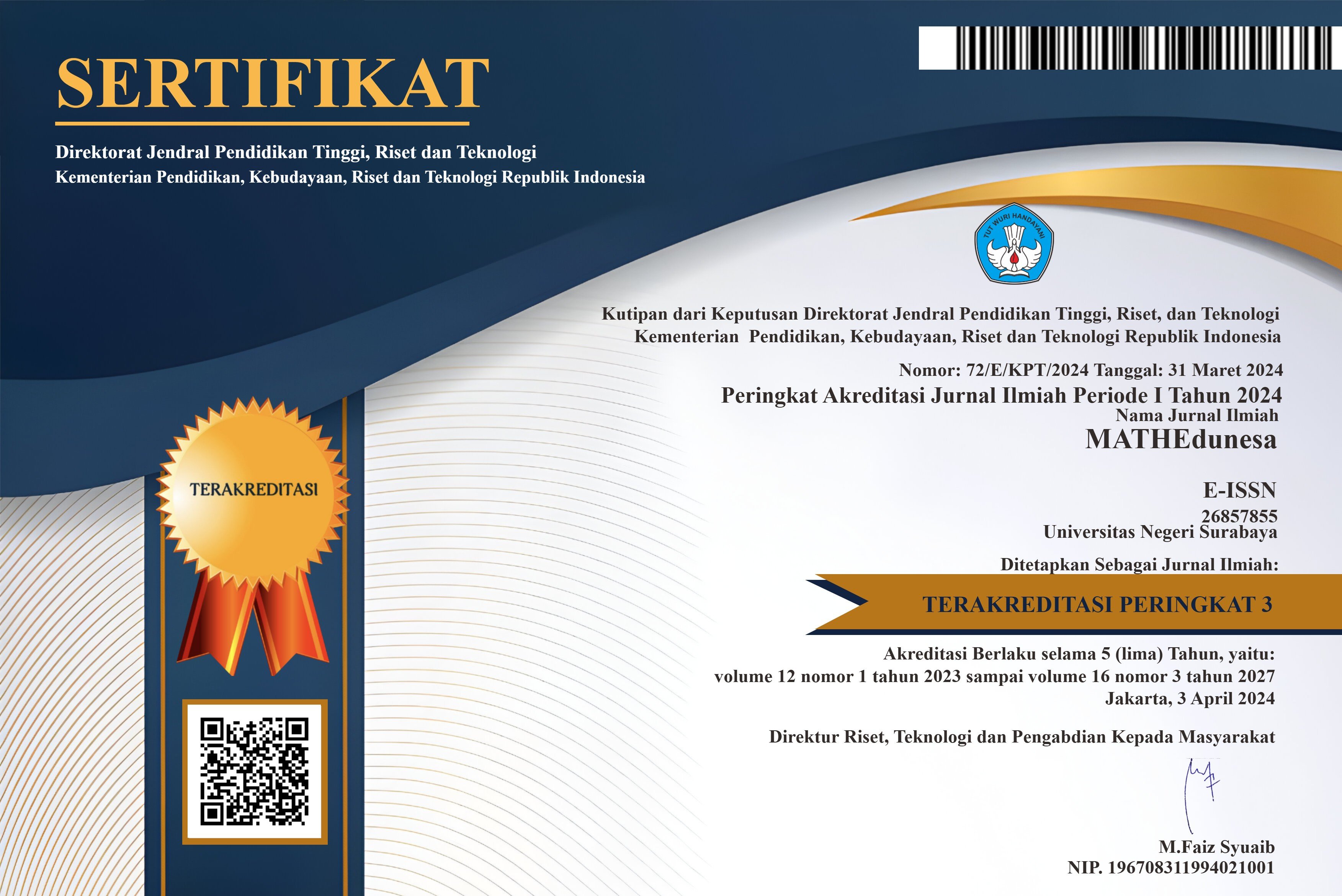PENALARAN ANALOGI SISWA SMK DALAM PEMECAHAN MASALAH GEOMETRI DITINJAU DARI KECERDASAN SPASIAL DAN LOGIS-MATEMATIS
DOI:
https://doi.org/10.26740/mathedunesa.v7n2.p%25pAbstract
Abstrak
Pemecahan masalah geometri adalah salah satu keterampilan yang sangat terkait dengan kecerdasan spasial dan logis-matematis. Siswa SMK sering kali masih mengalami kesulitan dalam memecahkan masalah geometri meskipun masalah tersebut memiliki kesamaan relasional atau struktural dengan contoh masalah yang pernah mereka selesaikan. Penalaran analogi adalah suatu proses penting untuk membantu siswa memecahkan masalah-masalah yang memiliki kesamaan struktural atau relasional. Sehingga tujuan penelitian ini adalah mendeskripsikan penalaran analogi siswa SMK dalam pemecahan masalah geometri ditinjau dari kecerdasan spasial dan logis-matematis.
Penelitian ini dilakukan terhadap 3 subjek yang merupakan siswa SMK 3 Surabaya Jurusan Teknik Gambar Bangunan Kelas X dengan kecerdasan spasial dan logis-matematis yang berbeda yang dipilih berdasarkan hasil pengerjaan tes kecerdasan spasial dan logis-matematis. Kriteria subjek yang dipilih adalah siswa dengan kecerdasan spasial dan logis-matematis yang sama, kecerdasan spasial yang lebih tinggi dari kecerdasan logis-matematisnya, dan kecerdasan logis-matematis yang lebih tinggi dari kecerdasan spasialnya. Untuk mengetahui penalaran analogi subjek dalam pemecahan masalah geometri, maka subjek diberikan tes penalaran analogi dan wawancara. Hasil tes penalaran analogi dan wawancara kemudian dianalisis berdasarkan indikator penalaran analogi.
Berdasarkan hasil analisis, dapat disimpulkan bahwa siswa dengan kecerdasan spasial dan logis-matematis yang sama dan siswa dengan kecerdasan spasial lebih tinggi dari kecerdasan logis-matematisnya menentukan hubungan masalah sumber dan masalah target dengan memahami soal dan dengan melihat gambar yang terdapat pada soal atau gambar yang dibuat sebagai representasi gambar bangun yang informasinya termuat dalam soal. Sedangkan siswa dengan kecerdasan logis-matematis yang lebih tinggi dari kecerdasan spasial menentukan hubungan masalah sumber dan masalah target dengan melihat informasi yang ada pada soal dan strategi penyelesaian soal. Setiap siswa menyelesaikan masalah target dengan memodifikasi rumus atau prosedur yang digunakan untuk menyelesaikan masalah sumber berdasarkan pada hubungan antara masalah sumber dan masalah target yang telah ditemukan oleh siswa masing-masing.
Kata kunci: penalaran analogi, kecerdasan spasial, kecerdasan logis-matematis, masalah geometri
Abstract
Geometric problem solving is one of the skills related with spatial and logical-mathematical intelligence. Vocational high school students often have difficulty in solving geometric problems despite the problem has a relational or structural similarity with the examples of problems they once solved. Reasoning analogy is an important process to help students solve problems that have structural or relational similarities. Therefore, the purpose of this study is to describe the analogical reasoning of vocational students in solving geometric problems in terms of spatial and logical-mathematical intelligence.
The research was conducted on three subjects who are the tenth grade students of Surabaya 3 vocational high school majoring in engineering construction drawings with different condition of spatial and logical-mathematical intelligence selected based on the results of spatial and logical-mathematical intelligence tests. Selected subject criteria were students with the same spatial and logical-mathematical intelligence, higher spatial intelligence than logical-mathematical intelligence, and higher logical-mathematical intelligence than spatial intelligence. To determine an analogical reasoning of the selected subject in geometry problem solving, they were given the analogy reasoning tests and interviews. Analogy reasoning test results and interviews then analyzed based on analogy reasoning indicators.
Based on the analysis, it can be concluded that student with the same spatial and logical-mathematical intelligence and student with higher spatial intelligence than logical-mathematical intelligence determined the relationship of source problems and target problems by understanding the problems and by looking at the figure contained in the problems or figure created as a representation of the information contained in the problems. While student with higher logical-mathematical intelligence than spatial intelligence determined the relationship of source problems and target problems by looking at the information in the problems and problem solving strategies. Each student solves the target problems by modifying the formula or procedure used to solve the source problems based on the relationship between the source problems and the target problems that each student has discovered.
Keywords : analogy reasoning, spatial intelligence, logical-mathematical intelligence, geometric problemsDownloads
Downloads
Published
Issue
Section
 Abstract views: 131
,
Abstract views: 131
, PDF Downloads: 100
PDF Downloads: 100




